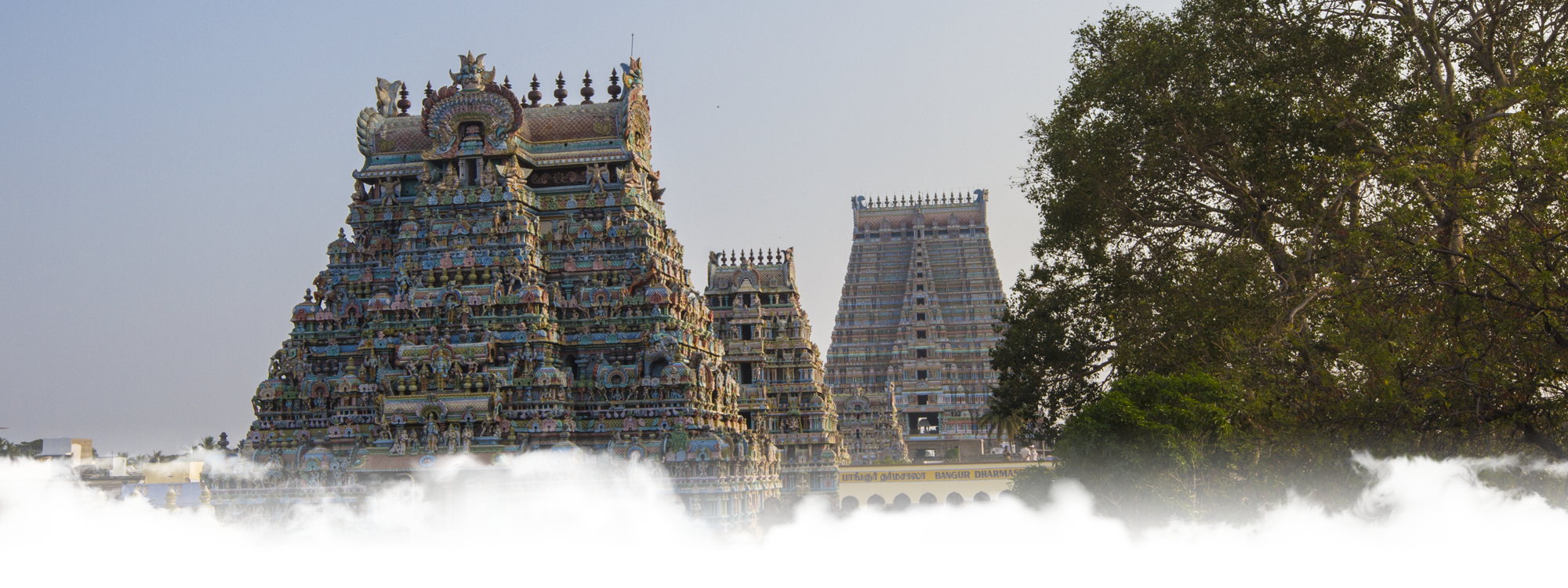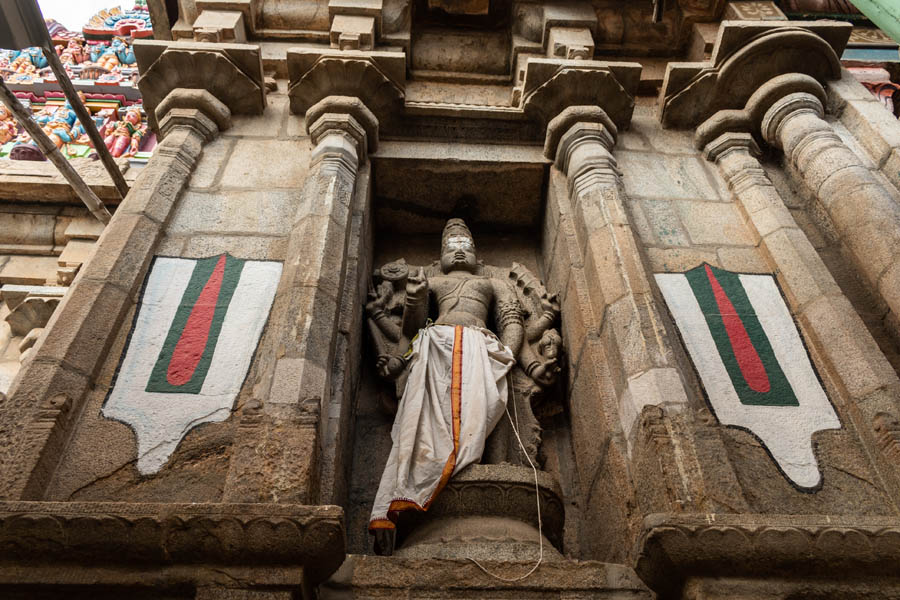
Srirangam Temple
Also known as the Sri Ranganathaswamy Temple or Thiruvaranga Tirupati, it is located in Tiruchirapalli, Tamil Nadu.
The smell of incense burning, the colors of marigold, bells, and chants fill the air! Ancient towers, intricate sculptures, mysticism, and legends! Srirangam is a marvel that attracts pilgrims as well as art, architecture, and history lovers. Dedicated to Sri Ranganatha, the reclining form of Lord Vishnu, it is an important religious site for Srivaishnavites.
It is built on an island surrounded by the Kaveri and Kollidam rivers. Sprawling an enormous 156 acres, Srirangam is the largest functioning Hindu Temple in the world.
It is considered the first and foremost of the 108 Divya Desams dedicated to Lord Vishnu and is one of the eight self-manifested shrines of the deity. Sri Ranganatha is lovingly called Azhagiya Manavaalan or the beautiful groom in Tamil by his devotees. Like all ancient temples, Srirangam is steeped in legend, folklore and mystical stories.
The Legend of Srirangam
Legend has it that the idol of Sri Ranganatha was received by Brahma in a deep state of meditation. Later, it came to be in the possession of Lord Rama, who worshiped it with pure devotion. It was Lord Rama, who gave the idol to Vibishana, the brother of Ravana; out of gratitude for helping him win the war.
Vibishana could take the idol to Sri Lanka, however, there was one condition. He should not place the idol on the ground or else it would get fixed in that place permanently. Now, on his way to Sri Lanka, he came across a festival at Srirangam. Not heeding to the advice received, he placed the idol on the banks of river Kaveri.
Lord Ranganatha liked the place and refused to leave. He, however, promised Vibishana that he will continue to bless him by facing the South. Even today, the deity faces the South direction.

Historical and Textual Evidence
Inscriptions
Mention in Religious Texts
Invasions of the Delhi Sultanate
Later years
Religious Significance
Spiritual Inquiry and Debate
The Bhakti Movement
The temple was also a hub for the Tamil Bhakti Movement with its devotional poetry, song, and dance tradition. The Azhwars or the divine saints of this movement have dedicated 247 hymns to Sri Ranganatha. They are compiled in the Nalayira Divya Prabhandam, which is a collection of 4000 hymns written by 12 Azhwar saints from the 6th to 9th century AD.
Festivals
The main festival is held around the Vaikunta Ekadashi (11th day of the month Margazhi), which falls in December or January. It attracts more than a million devotees. There are celebrations for 21 days, with much pomp and glory. There is singing, dancing, theatrics, and recitation of poetry. This is the best time to visit Srirangam.
On Ekadashi, after a long procession, the deity is placed in the 1000 pillared hall. It is said that whoever gazes at it will attain heaven after death. The place itself is said to become Bhooloka Vaikunta or Heaven on Earth. So blessed is Srirangam on this day that the entire pantheon of Hindu Gods comes to witness it. The other festivals of importance are Jyestabisheka, Brahmotsavam, and the annual Rathothsavam. While of major religious significance, Srirangam is also known for its brilliant architecture.
Ancient Dravidian Architecture
Prakaras
The temple was also a hub for the Tamil Bhakti Movement with its devotional poetry, song, and dance tradition. The Azhwars or the divine saints of this movement have dedicated 247 hymns to Sri Ranganatha. They are compiled in the Nalayira Divya Prabhandam, which is a collection of 4000 hymns written by 12 Azhwar saints from the 6th to 9th century AD.
Gopuram and Mandapams
Shrines
Mystical Stories
The Muslim Princess:
In the 13th Century, Malik Kafur, the general of Sultan Alauddin Khilji, invaded the temple and took the idol with him to Delhi. Devotees of the deity, dressed as a band of performers traveled to his court, impressing him requested the idol as a reward. And he obliged. Delighted, returning home with the deity, they were followed by princess Surathani, who had fallen madly in love with Sri Ranganatha. She prostrated before him and attained moksha. Her shrine is still present in the temple compound.
This, however, angered the Sultan and led to another invasion, causing a massacre. The deity and his consort Sri Ranganayaki were cleverly shifted before they could be stolen again. They traveled from village to village until reinstated in the temple only 60 years later.
The Little Garland Girl:
Andal, a little girl found under the Tulsi plant was adopted by a priest and cared for like his own. Her duty was to make garlands to be offered to Lord Ranganatha. She would however wear the garlands first, to make sure they were perfect. One day, the priest caught her in the act and apprehended her for offering used garlands to the deity.
The deity, however, protested at the fresh new garlands offered and said, “Where is the scent of the girl, who will be my future wife?” He came to the priest in a dream and asked to be offered only the garlands worn by her. And sure enough, the deity appeared riding an elephant and was married to Andal. Their love story is still celebrated today as Andal Kalyanam on Bhogi Pongal.
The Cursed Diamond:
The Shrine of Ramanuja:
Interesting Facts
It hosts the tallest tower in Asia. Known as the Rajagopuram, the tower stands at a height of 236 feet. Amongst the many water tanks at Srirangam, two of the largest are known to hold 2 million liters of water.
The main idol of the temple which is the reclining Vishnu is made of stucco and thailam, a paste made out of camphor, honey, musk, jaggery, and sandal. The walls are painted in exquisite designs using vegetable and herbal dyes. Srirangam has survived many invasions and natural disasters and has been rebuilt over many centuries. It has been nominated as a UNESCO world heritage site.

